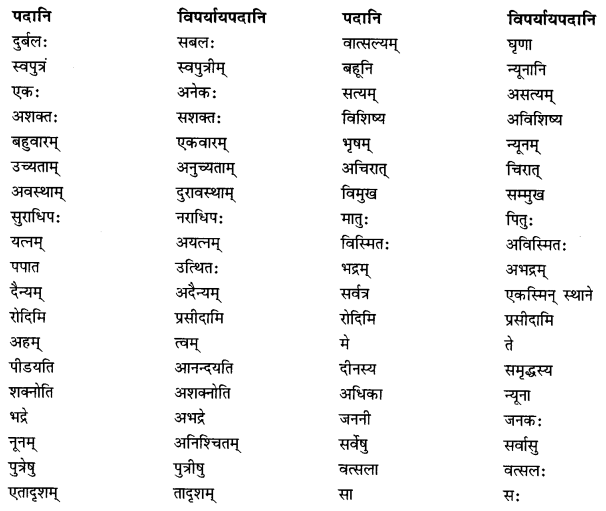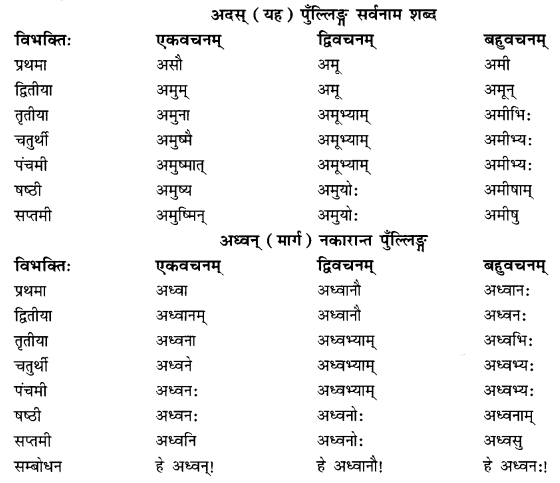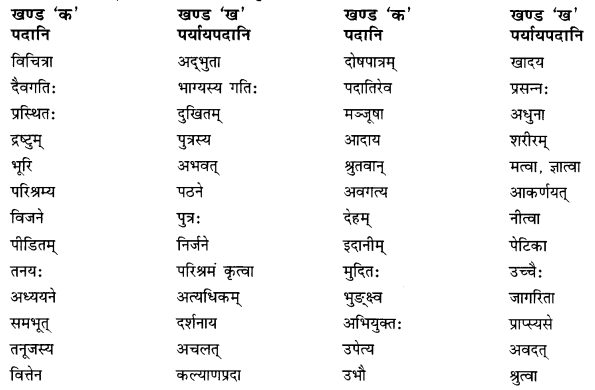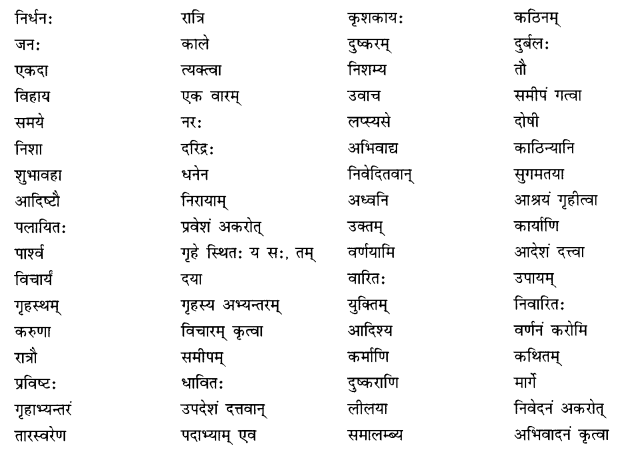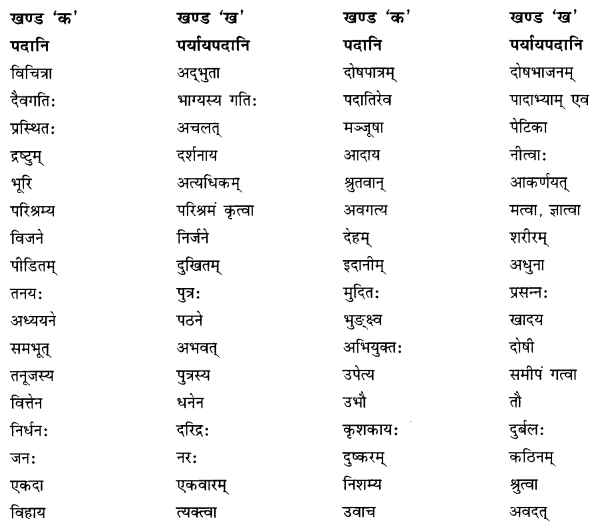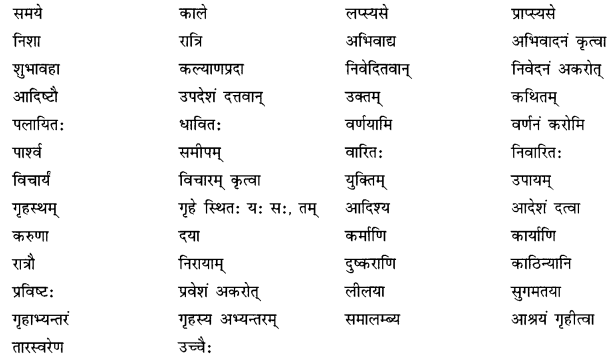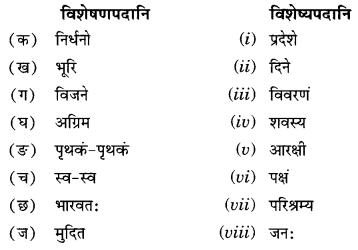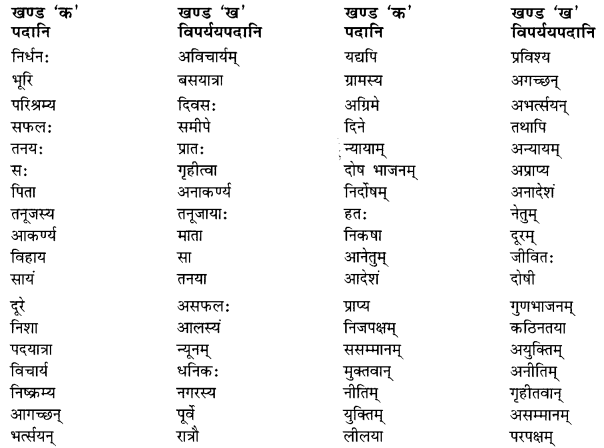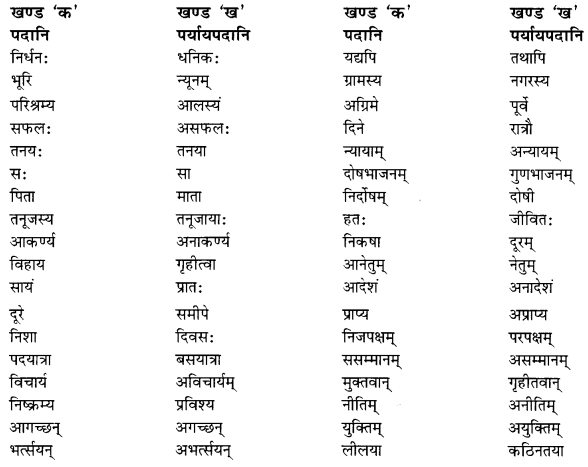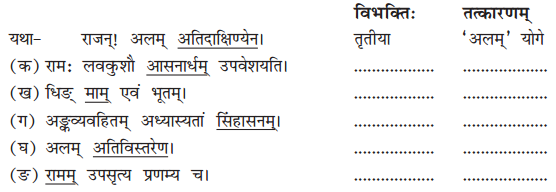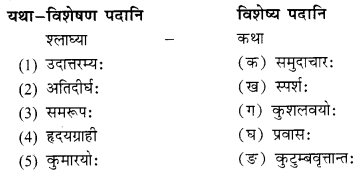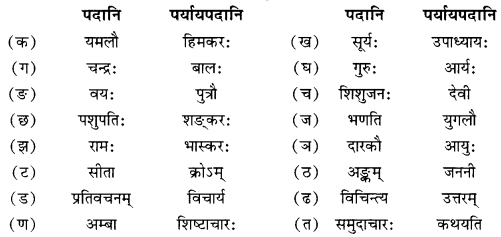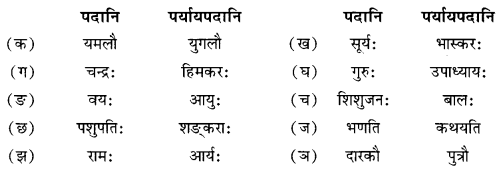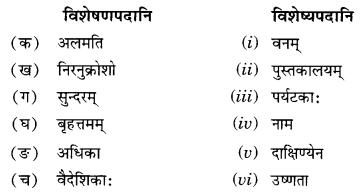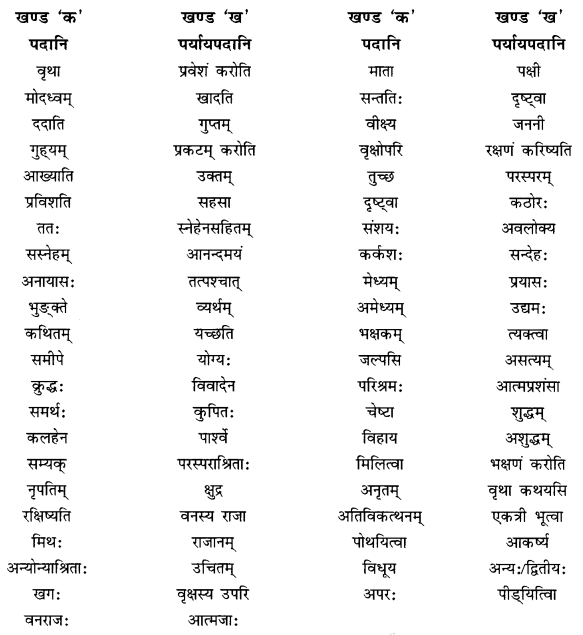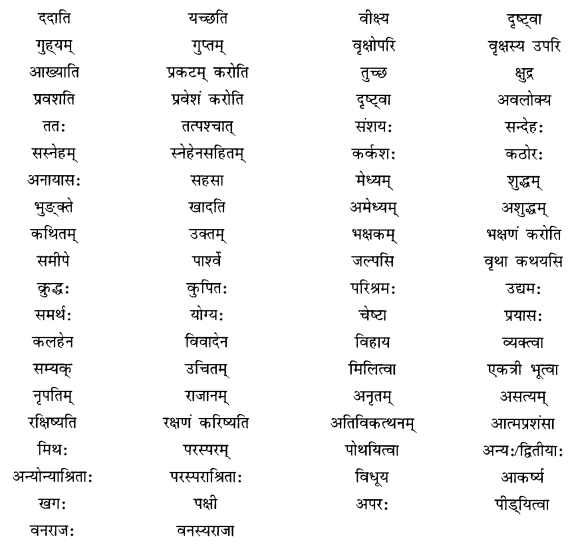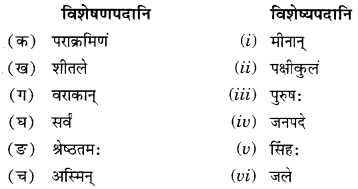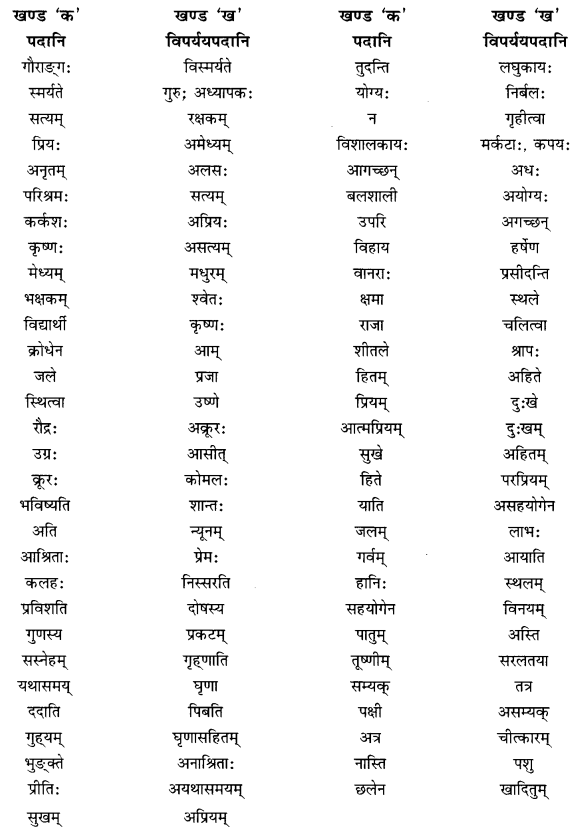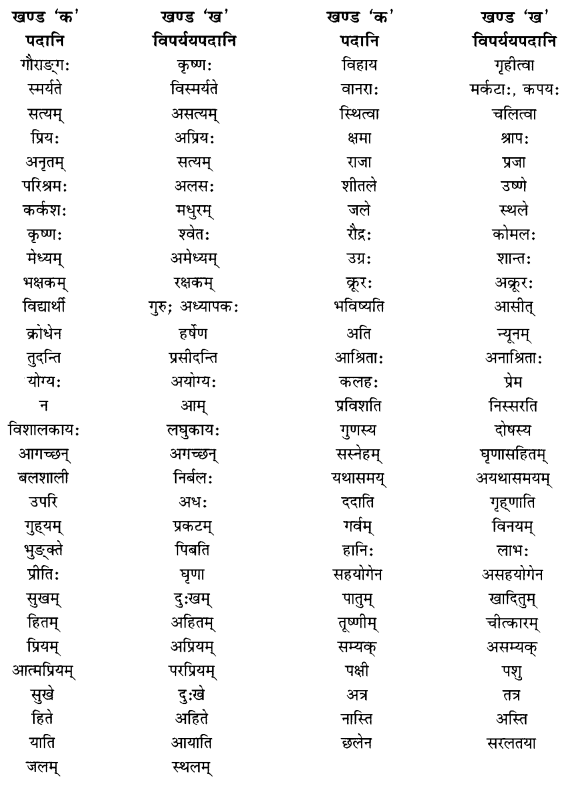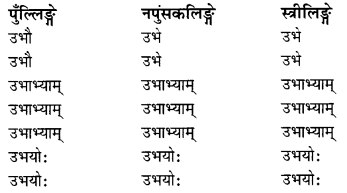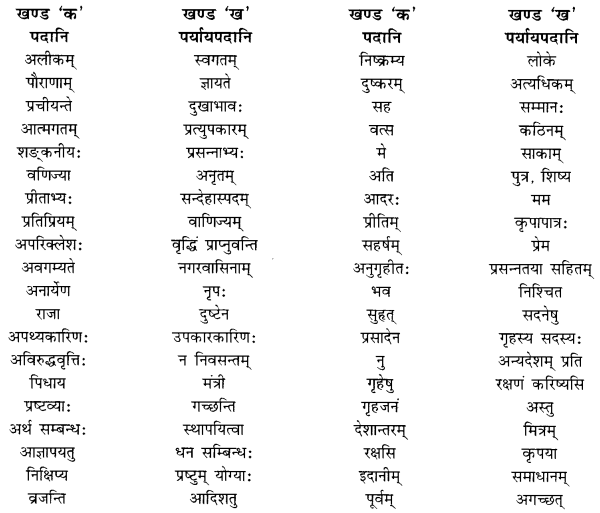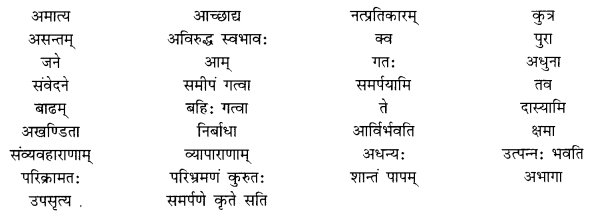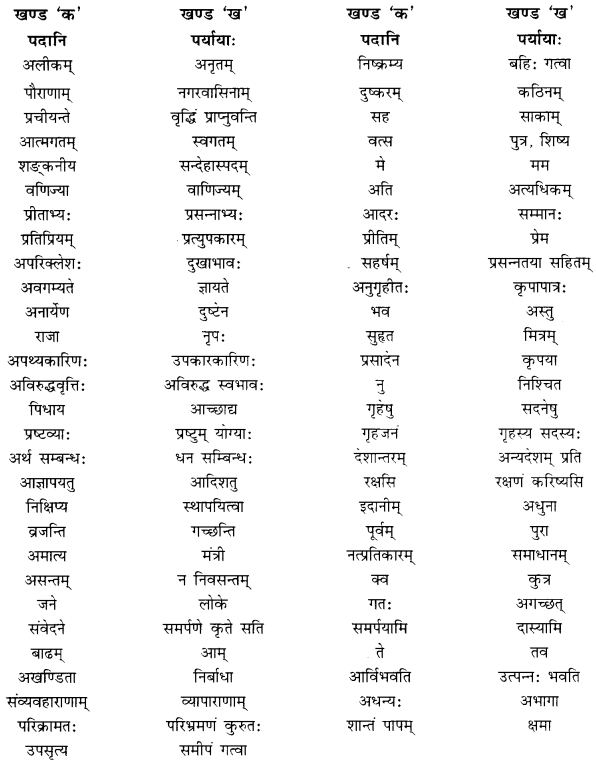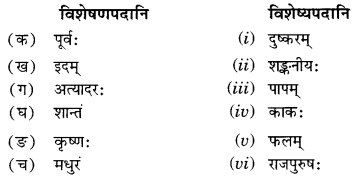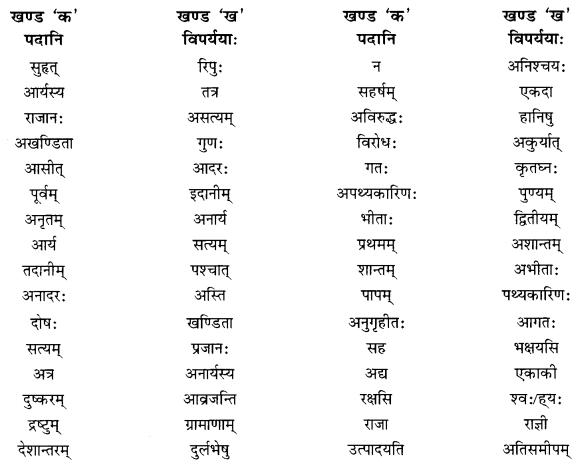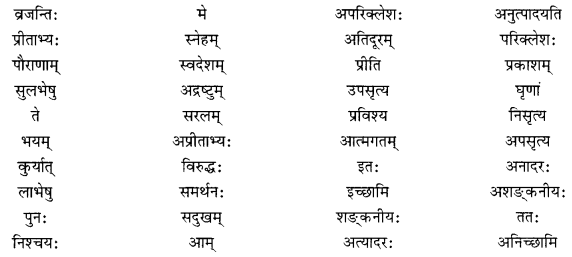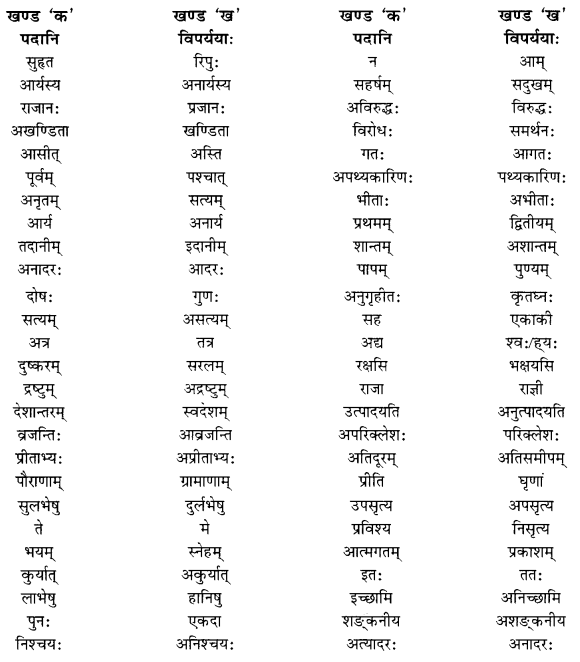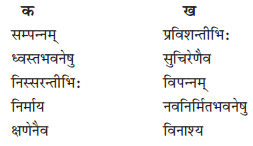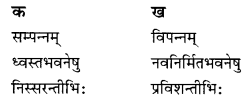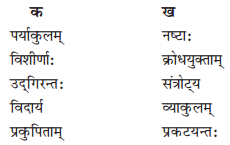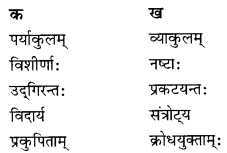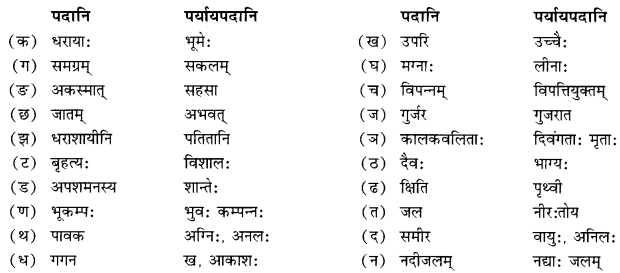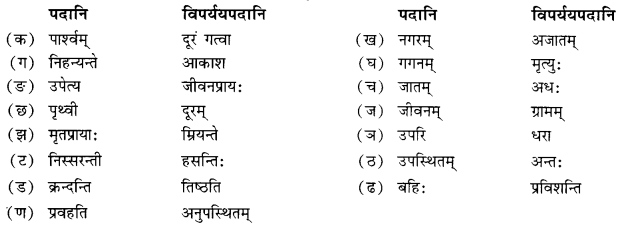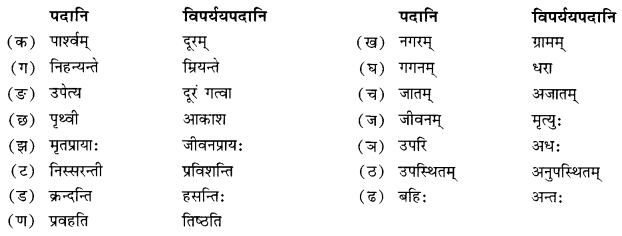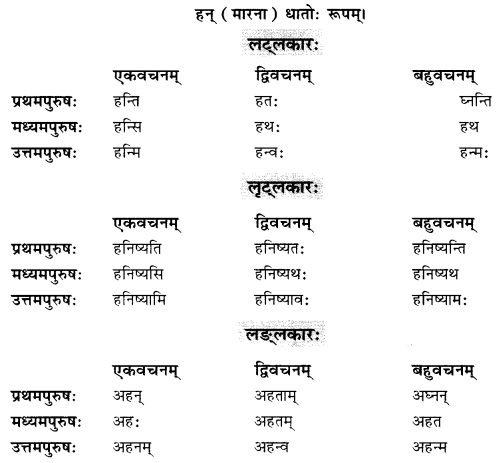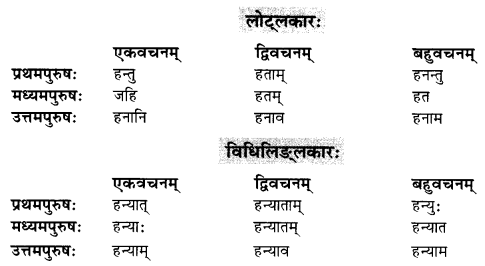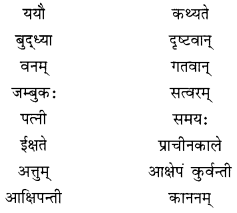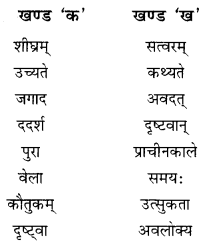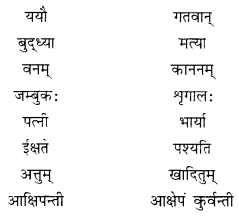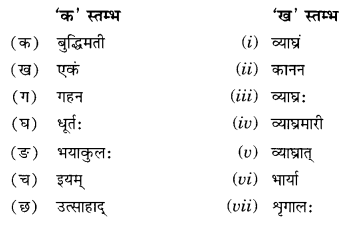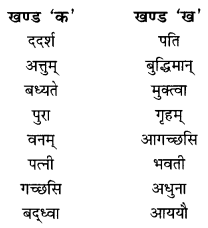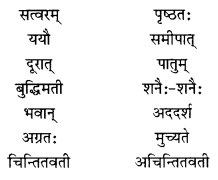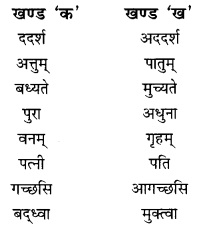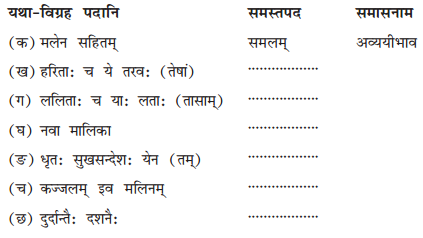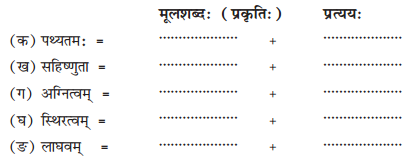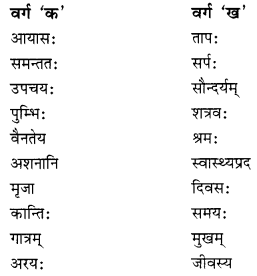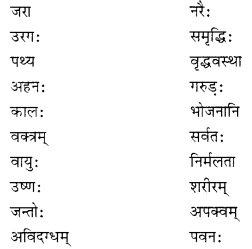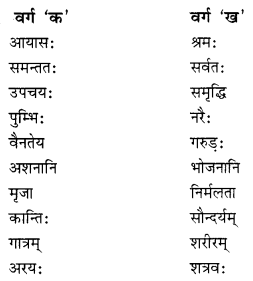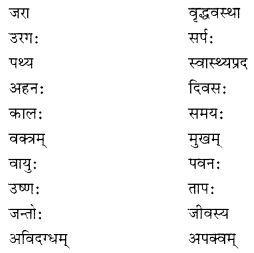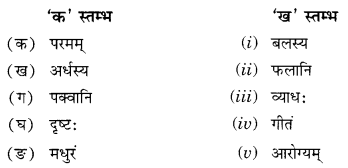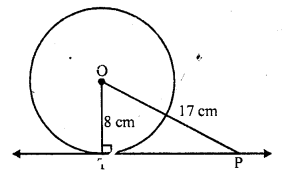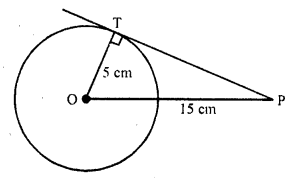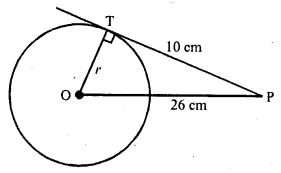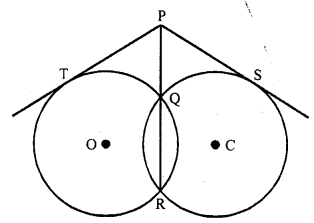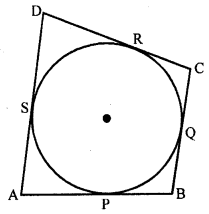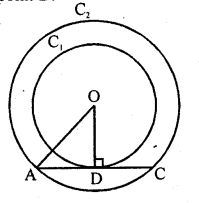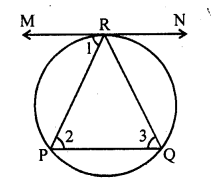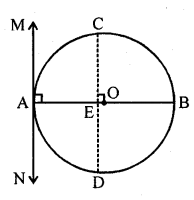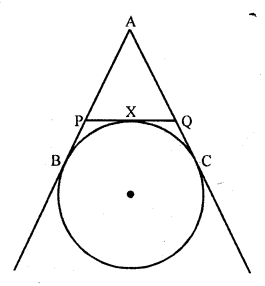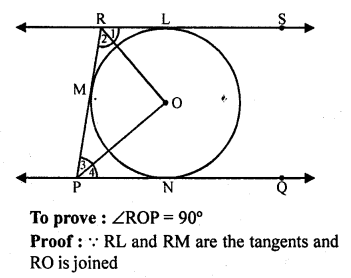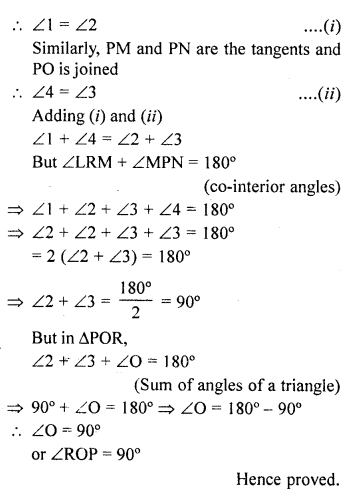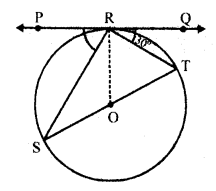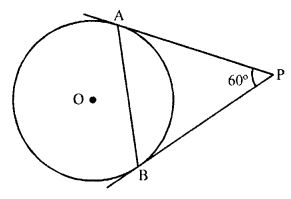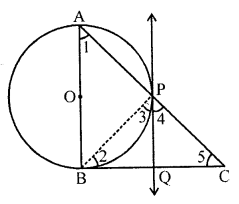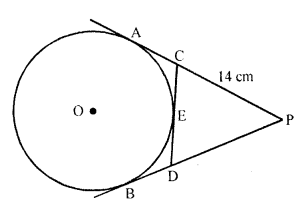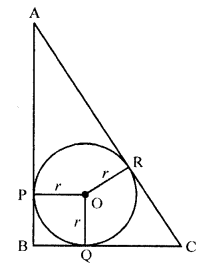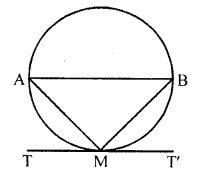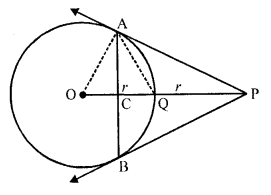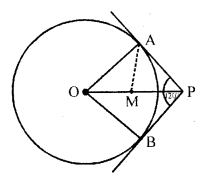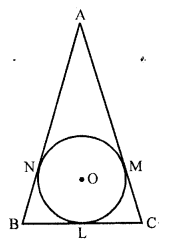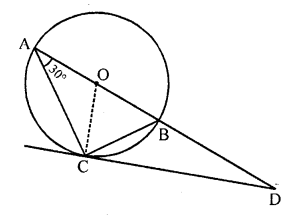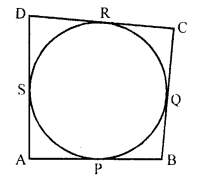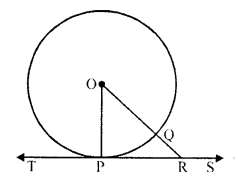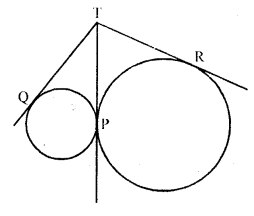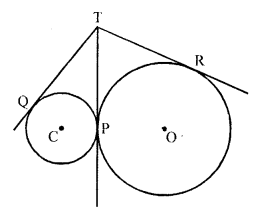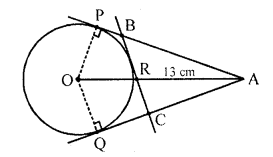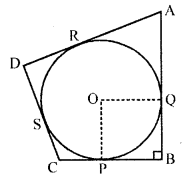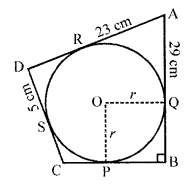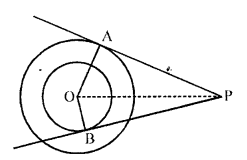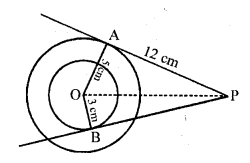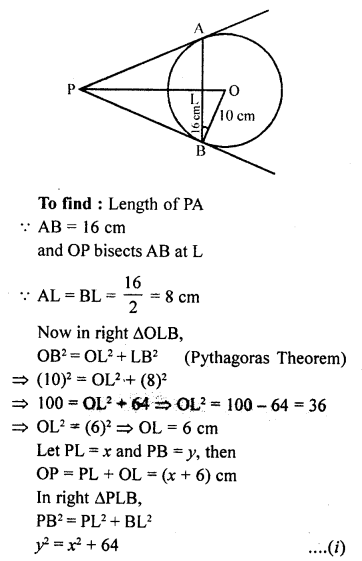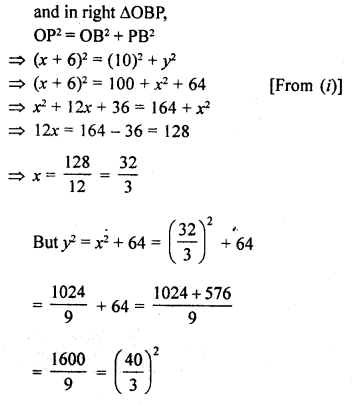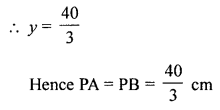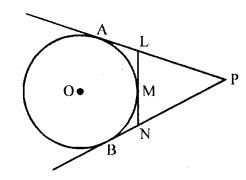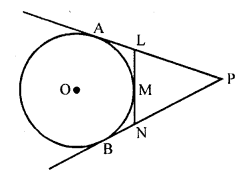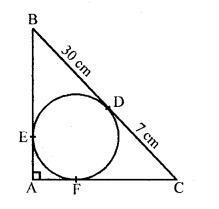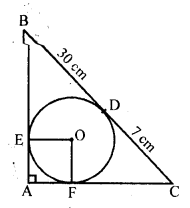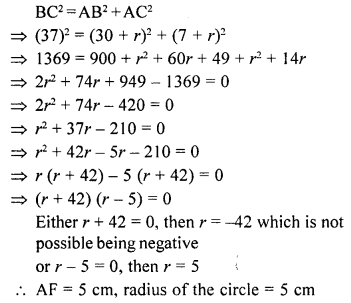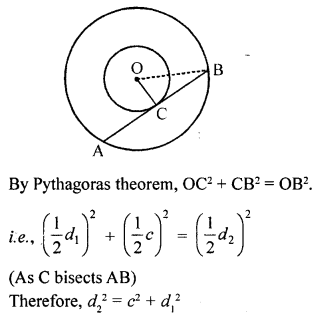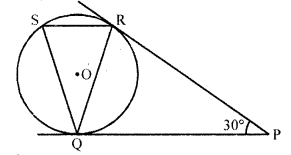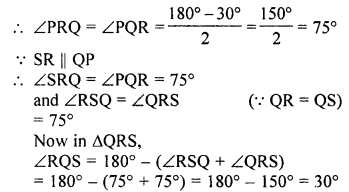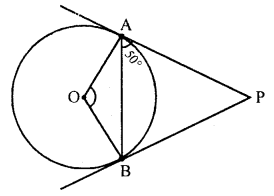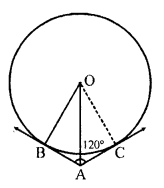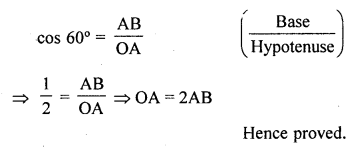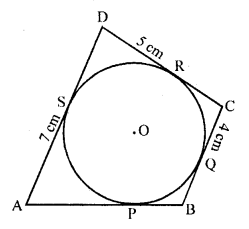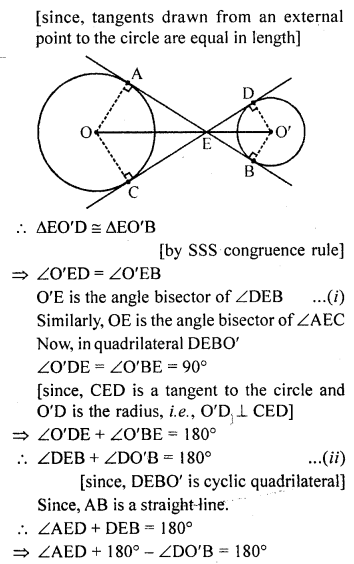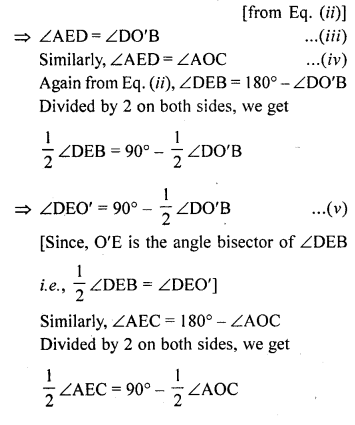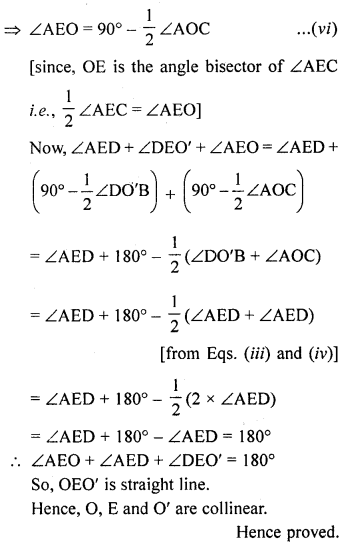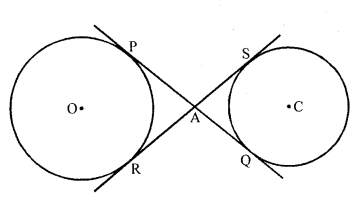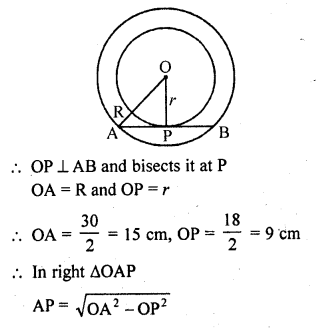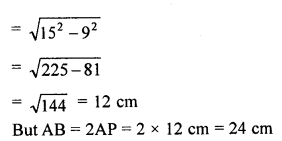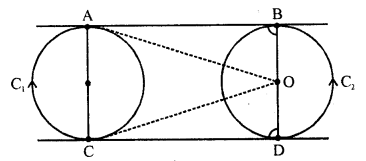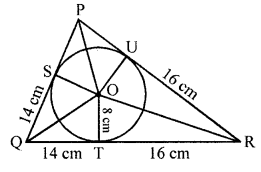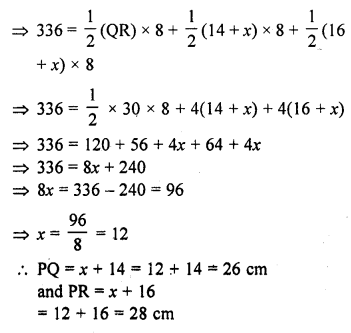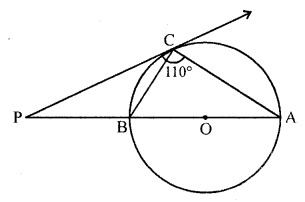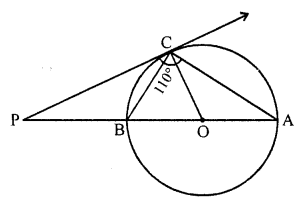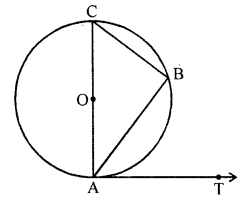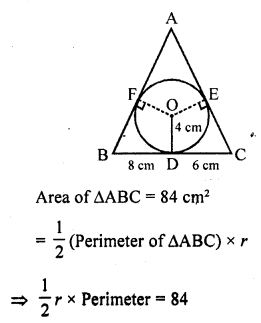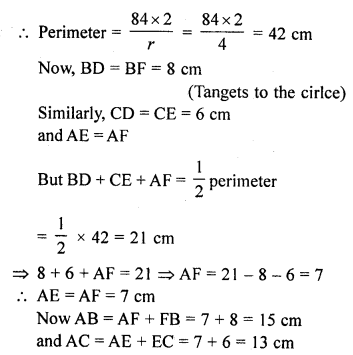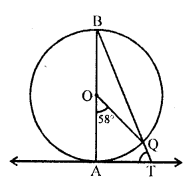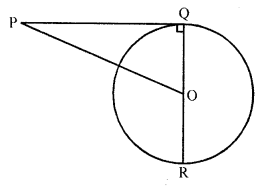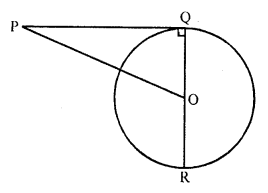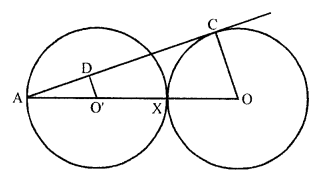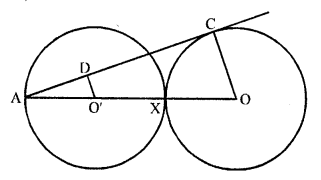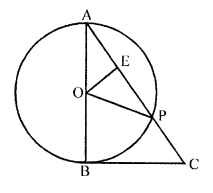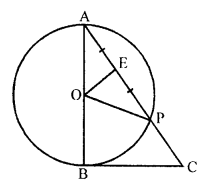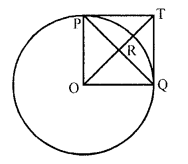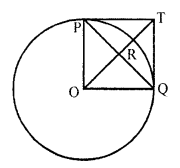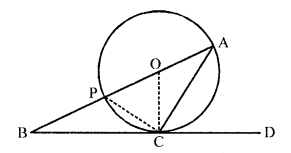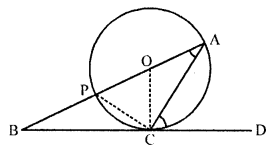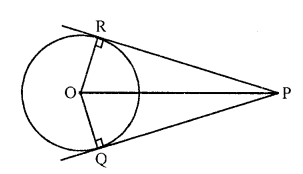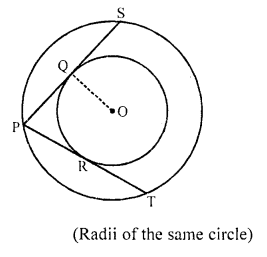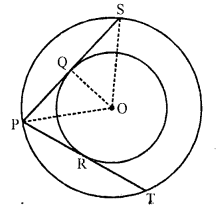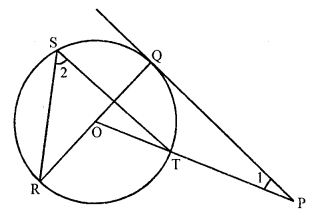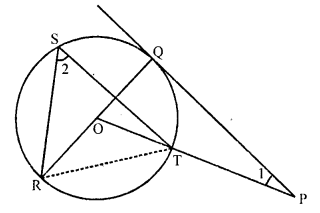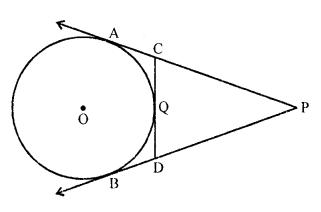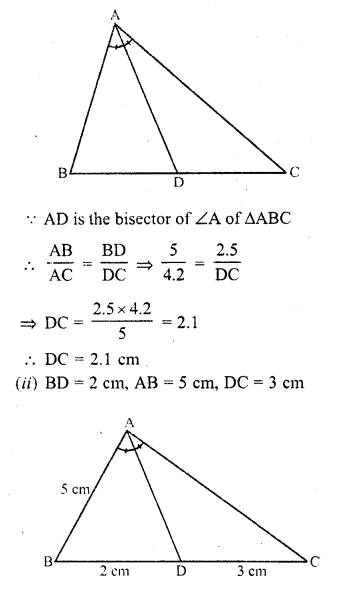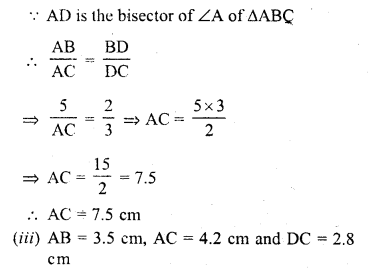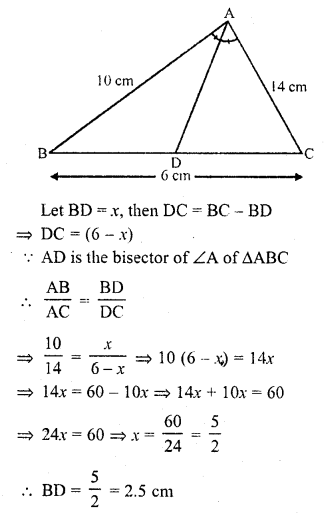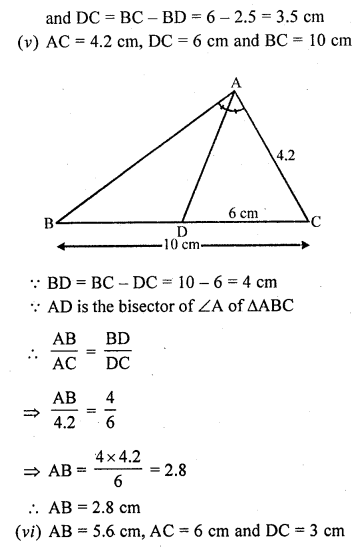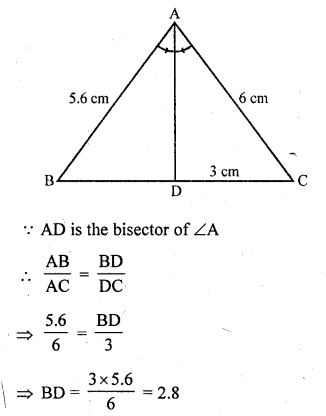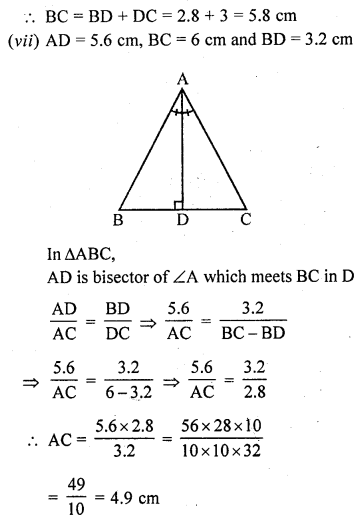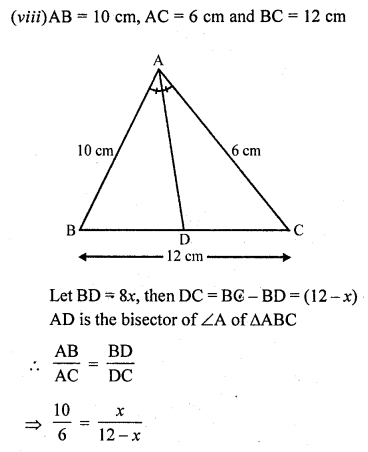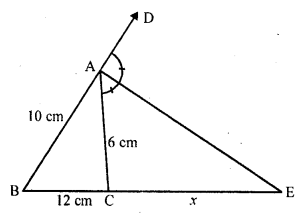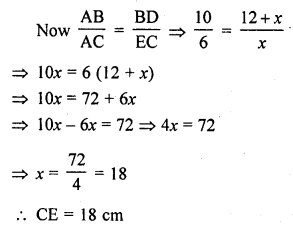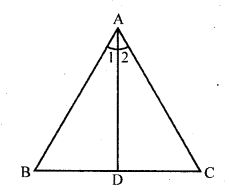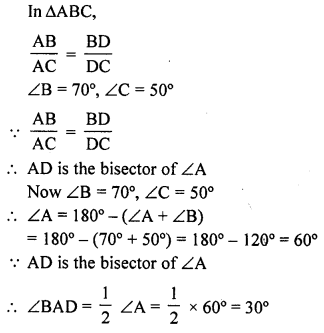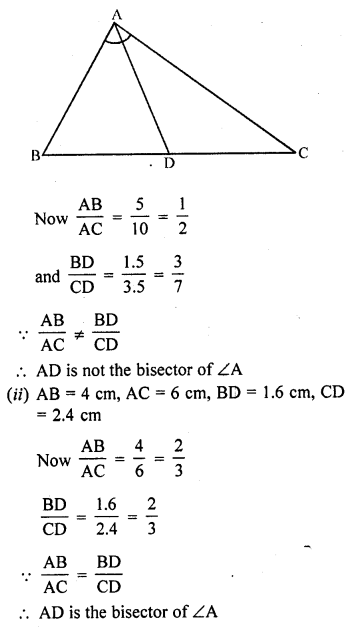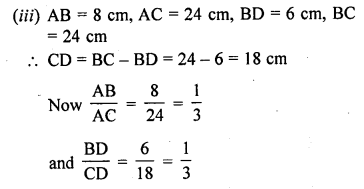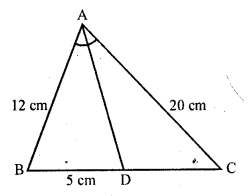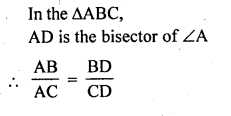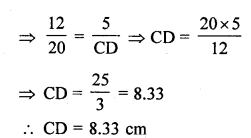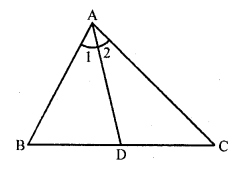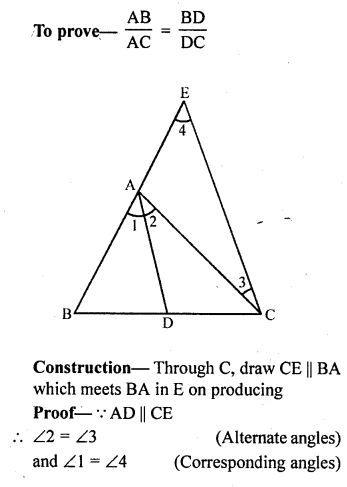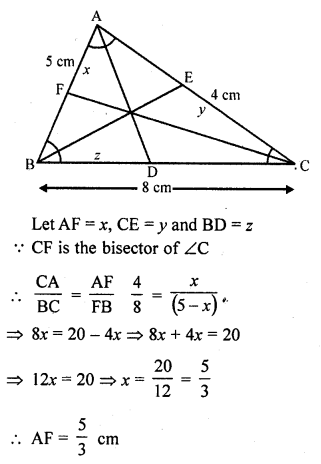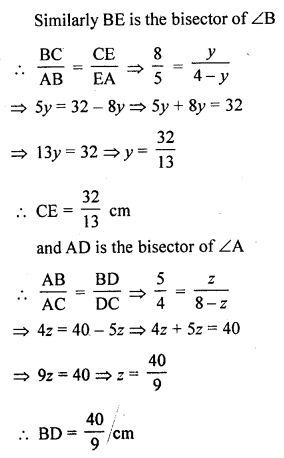We have given detailed NCERT Solutions for Class 10 Sanskrit Shemushi Chapter 5 जननी तुल्यवत्सला Questions and Answers come in handy for quickly completing your homework.
Shemushi Sanskrit Class 10 Solutions Chapter 5 जननी तुल्यवत्सला
Class 10 Sanskrit Shemushi Chapter 5 जननी तुल्यवत्सला Textbook Questions and Answers
अभ्यासः
प्रश्न 1.
एकपदेन उत्तरं लिखत-
(क) वृषभः दीनः इति जानन्नपि कः तं नुद्यामान् आसीत्?
उत्तराणि:
कृषकः
(ख) वृषभः कुत्र पपात?
उत्तराणि:
क्षेत्रे
(ग) दुर्बले सुते कस्याः अधिका कृपा भवति?
उत्तराणि:
मातुः
(घ) कयोः एकः शरीरेण दुर्बलः आसीत्?
उत्तराणि:
बलीवर्दयोः
(ङ) चण्डवातेन मेघरवैश्च सह कः समजायत?
उत्तराणि:
प्रवर्ष:
प्रश्न 2.
अधोलिखितानां प्रश्नानाम् उत्तराणि संस्कृतभाषया लिखत-
(क) कृषक: किं करोति स्म?
उत्तराणि:
कृषकः क्षेत्रकर्षणं करोति स्म।
(ख) माता सुरभिः किमथम् अश्रूणि मुञ्चति स्म?
उत्तराणि:
भूमौ पतिते स्वपुत्रं दृष्ट्वा माता सुरभिः अश्रूणि मुञ्चति स्म।
(ग) सुरभिः इन्द्रस्य प्रश्नस्य किमुत्तर ददाति?
उत्तराणि:
सुरभिः इन्द्रस्य इदम् उत्तरं ददाति-” भो वासव! पुत्रत्य दैन्यं दृष्ट्वा अहं रोदिमि।”
(घ) मातुः अधिका कृपा कस्मिन् भवति?
उत्तराणि:
मातुः अधिका कृपा दीने पुत्रे भवति।
(ङ) इन्द्रः दुर्बलवृषभस्य कष्टानि अपाकर्तुं किं कृतवान्?
उत्तराणि:
इन्द्रः दुर्बलवृषभस्य कष्टानि अपाकर्तुं प्रवर्ष कृतवान्।
(च) जननी कीदृशी भवति?
उत्तराणि:
जननी सर्वेषु अपत्येषु तुल्यवत्सला परं दीने पुत्र कृपाहदया भवति।
(छ) पाठेऽस्मिन् कयोः संवादः विद्यते?
उत्तराणि:
अस्मिन् पाठे सुरभिसुराधिपइन्द्रयोः संवाद: विद्यते।
प्रश्न 3.
‘क’ स्तम्भे दत्तानां पदानां मेलनं ‘ख’ स्तम्भे दत्तैः समानार्थकपदौः कुरुत-
क स्तम्भ – ख स्तम्भ
(क) कृच्छ्रेण – (i) वृषभः
(ख) चक्षुभ्या॑म – (ii) वासवः
(ग) जवने – (iii) नेत्राभ्याम्
(घ) इन्द्रः – (iv) अचिरम्
(ङ) पुत्राः – (v) द्रुतगत्या
(च) शीघ्रम् – (vi) काठिन्येन
(छ) बलीवर्दः – (vii) सुताः
उत्तराणि:
क स्तम्भ – ख स्तम्भ
(क) कृच्छेण – (i) काठिन्येन
(ख) चक्षुाम् – (ii) नेत्राभ्याम्
(ग) जवने – (iii) द्रुतगत्या
(घ) इन्द्रः – (iv) वासवः
(ङ) पुत्राः – (v) सुताः
(च) शीघ्रम् – (vi) अचिरम्
(छ) बलीवर्दः – (vii) वृषभः
प्रश्न 4.
स्थूलपदमाधृत्य प्रश्ननिर्माणं कुरुत-
(क) सः कृच्छ्रेण भारम् उद्वहति।
उत्तराणि:
सः केन/कथम् भारम् उद्वहति?
(ख) सुराधिपः ताम् अपृच्छत्?
उत्तराणि:
कः ताम् अपृच्छत्?
(ग) अयम् अन्येभ्यो दुर्बलः।
उत्तराणि:
अयम् केभ्यः/ केभ्यो दुर्बलः?
(घ) धेनूनाम् माता सुरभिः आसीत्?
उत्तराणि:
कासाम् माता सुरभिः आसीत्?
(ङ) सहस्राधिकेषु पुत्रेषु सत्स्वपि सा दु:खी आसीत्।
उत्तराणि:
कति पुत्रेषु सत्स्वपि सा दु:खी आसीत्?
प्रश्न 5.
रेखांकितपदे यथास्थानं सन्धि विच्छेद वा कुरुत-
(क) कृषक: क्षेत्रकर्षणं कुर्वन् + आसीत्।
उत्तराणि:
कुर्वन्नासीत्
(ख) तयोरेक: वृषभः दुर्बलः आसीत्।
उत्तराणि:
तयोः + एकः
(ग) तथापि वृषः न + उत्थितः।
उत्तराणि:
नोत्थितः
(घ) सत्स्वपि बहुषु पुत्रेषु अस्मिन् वात्सल्यं कथम्?
उत्तराणि:
सत्सु + अपि
(ङ) तथा + अपि + अहम् + एतस्मिन् स्नेहम् अनुभवामि।
उत्तराणि:
तथाप्यहमेतस्मिन्
(च) मे बहूनि + अपत्यानि सन्ति।
उत्तराणि:
बहून्यपत्यानि
(छ) सर्वत्र जलोपप्लवः संजात:।
उत्तराणि:
जल + उपलव:
प्रश्न 6.
अधोलिखितेषु वाक्येषु रेखांकितसर्वनामपदं कस्मै प्रयुक्तम्-
(क) सा च अवदत् भो वासव! भृशं दु:खिता अस्मि।
उत्तराणि:
धेनुमात्रे सुरभये (सुरभ्यै)।
(ख) पुत्रस्य दैन्यं दृष्ट्वा अहम् रोदिमि।
उत्तराणि:
धेनुमात्रे सुरभये (सुरभ्यै)।
(ग) सः दीनः इति जानन् अपि कृषक: तं पीडयति।
उत्तराणि:
दुर्बल बलीवय।
(घ) मे बहूनि अपत्यानि सन्ति।
उत्तराणि:
धेनुमात्रे सुरभये (सुरभ्यै)।
(ङ) सः च ताम् एवम् असान्त्वयत्।
उत्तराणि:
आखण्डलाय (इन्द्राय)।
(च) सहस्रेषु पुत्रेषु सत्सवपि तव अस्मिन् प्रीतिः अस्ति।
उत्तराणि:
धेनुमात्रे सुरभये (सुरभ्यै)।
प्रश्न 7.
‘क’ स्तम्भे विशेषणपदं लिखितम्, ‘ख’ स्तम्भे पुनः विशेष्यपदम्। तयोः मेलनं कुरुत-
क स्तम्भ – ख स्तम्भ
(क) कश्चित् – (i) वृषभम्
(ख) दुर्बलम् – (ii) कृपा
(ग) क्रुद्धः – (iii) कृषीवल:
(घ) सहस्राधिकेषु – (iv) आखण्डल:
(ङ) अभ्यधिका – (v) जननी
(च) विस्मितः – (vi) पुत्रेषु
(छ) तुल्यवत्सला – (vii) कृषक:
उत्तराणि:
क स्तम्भ – ख स्तम्भ
(क) कश्चित् – (i) कृषक:
(ख) दुर्बलम् – (ii) वृषभम्
(ग) क्रुद्धः – (iii) कृषीवल:
(घ) सहस्राधिकेषु – (iv) पुत्रेषु
(ङ) अभ्यधिका – (v) कृपा
(च) विस्मितः – (vi) आखण्डल:
(छ) तुल्यवत्सला – (vii) जननी
योग्यताविस्तारः
महाभारत में अनेक ऐसे प्रसंग हैं जो आज के युग में भी उपादेय हैं। महाभारत के वनपर्व से ली गई यह कथा न केवल मनुष्यों अपितु सभी जीव-जन्तुओं के प्रति समदृष्टि पर बल देती है। समाज में दुर्बल लोगों अथवा जीवों के प्रति भी माँ की ममता प्रगाढ़ होती है, यह इस पाठ का अभिप्रेत है। प्रस्तुत पाठ्यांश महाभारत से उद्धत है, जिसमें मुख्यतः व्यास द्वारा धृतराष्ट्र को एक कथा के माध्यम से यह संदेश देने का प्रयास किया गया है कि तुम पिता हो और एक पिता होने के नाते अपने पुत्रों के साथ-साथ अपने भतीजों के हित का खयाल रखना भी उचित है। इस प्रसंग में गाय के मातृत्व की चर्चा करते हुए गोमाता सुरभि और इन्द्र के संवाद के माध्यम से यह बताया गया है कि माता के लिए सभी सन्तान बराबर होती हैं। उसके हृदय में सबके लिए समान स्नेह होता है। इस कथा का आधार महाभारत, वनपर्व, दशम अध्याय, श्लोक संख्या 8 से श्लोक 16 तक है। महाभारत के विषय में एक श्लोक प्रसिद्ध है,
धर्मे अर्थे च कामे च मोक्षे च भरतर्षभ।
यदिहास्ति तदन्यत्र बन्नेहास्ति न तत् क्वचित्॥
अर्थात-धर्म, अर्थ, काम और मोक्ष इन पुरुषार्थ-चतुष्टय के बारे में जो बातें यहाँ हैं वे तो अन्यत्र मिल सकती हैं, पर जो कुछ यहाँ नहीं है, वह अन्यत्र कहीं भी उपलब्ध नहीं है।
उपरोक्त पाठ में मानवीय मूल्यों की पराकाष्ठा दिखाई गई है। यद्यपि माता के हृदय में अपनी सभी सन्ततियों के प्रति समान प्रेम होता है, पर जो कमजोर सन्तान होती है उसके प्रति उसके मन में अतिशय प्रेम होता है।
मातृमहत्त्वविषयक श्लोक-
नास्ति मातृसमा छाया, नास्ति मातृसमा गतिः।
नास्ति मातृसमं त्राणं, नास्ति मातृसमा प्रिमा।।
-वेदव्यास
उपाध्यायान्दशाचार्य, आर्चायेभ्यः शतं पिता।
सहस्रं तु पितृन् माता, गौरवेणातिरिच्यते॥
-मनुस्मृति
माता गुरुतरा भूमेः, खात् पितोच्चतरस्तथा।
मनः शीघ्रतरं वातात्, चिन्ता बहुतरी तृणात्।
-महाभारत
निरतिशयं गरिमाणं तेन जनन्याः स्मरन्ति विद्वांसः।
यत् कमपि वहति गर्भे महतामपि स गुरुर्भवति॥
भारतीय संस्कृति में गौ का महत्व अनादिकाल से रहा है। हमारे यहाँ सभी इच्छित वस्तुओं को देने की क्षमता गाय में है, इस बात को कामधेनु की संकल्पना से समझा जा सकता है। कामधेनु के बारे में यह माना जाता है कि उनके सामने जो भी इच्छा व्यक्त की जाती है वह तत्काल फलवती हो जाती है।
काले फलं यल्लभते मनुष्यो
न कामधेनोश्च समं द्विजेभ्यः॥
कल्यारथानां करिवाजियुक्तैः
शतैः सहस्रैः सततं द्विजेभ्यः॥
दत्तैः फलं यल्लभते मनुष्यः
समं तथा स्यान्नतु कामधेनोः॥
गाय के महत्व के संदर्भ में महाकवि कालिदास के रघुवंश में, सन्तान प्राप्ति की कामना से राजा दिलीप द्वारा ऋषि वशिष्ठ की कामधेनु नन्दिनी की सेवा और उनकी प्रसन्नता से प्रतापी पुत्र प्राप्त करने की कथा भी काफी प्रसिद्ध है। आज भी गाय की उपयोगिता प्रायः सर्वस्वीकृत ही है।
एकत्र पृथ्वी सर्वा, सशैलवनकानना।
तस्याः गौायसी, साक्षादेकत्रोभ्यतोमुखी॥
गावो भूतं च भव्यं च, गाव: पुष्टिः सनातनी।
गावो लक्षम्यास्तथाभूतं, गोषु दत्तं न नश्यति॥
Class 10 Sanskrit Shemushi Chapter 5 जननी तुल्यवत्सला Additional Important Questions and Answers
अतिरिक्त प्रश्नाः
1. अधोलिखितं गद्याशं पठित्वा गद्यांशाधारिताना प्रश्नानाम् उत्तराणि निर्देशानुसार लिखित-
(क) कश्चित् कृषकः बलीवाभ्यां क्षेत्रकर्षणं कुर्वन्नासीत्। तयोः बलीवर्दयोः एकः शरीरेण दुर्बलः जवेन गन्तुमशक्तश्चासीत् अतः कृषकः तं दुर्बलं वृषभं तोदनेन नुद्यमानः अवर्तत। स ऋषभः हलमूढ्वा गन्तुमशक्तः क्षेत्रे पपात। क्रुद्धः कृषीवलः तमुत्थापयितुं बहुवारम् यत्नमकरोत्। तथापि वृषः नोत्थितः।
भूमी पतिते स्वपुत्रं दृष्ट्वा सर्वधेनूनां मातुः सुरभेः नेत्राभ्यामश्रूणि आविरासन्। सुरभेरिमामवस्था दृष्ट्वा
सुराधिपः तामपृच्छत्-“अयि शुभे! किमेवं रोदिषि? उच्यताम्” इति। सा च
प्रश्न 1.
एकपदेन उत्तरत (केवलं प्रश्नद्वयमेव)-
- कृषक: काभ्याम् क्षेत्रकर्षणं कुर्वन्नासीत्?
- एक: बलीवर्दः कीदृशः आसीत्?
- कः गन्तुम् अशक्तः आसीत्?
उत्तराणि:
- बलीवर्दाभ्याम्
- दुर्बलः
- एकः (वृषभः)
प्रश्न 2.
पूर्णवाक्येन उत्तरत (केवलं प्रश्नमेकमेव)-
- सर्वधेनूनां माता सुरभिः किमर्थम् रुदन्ती आसीत्?
- कश्चित् कृषक: किं कुर्वन् आसीत्?
उत्तराणि:
- सर्वधेनूनां माता भूमौ पतिते स्वपुत्रं दृष्ट्वा रुदन्ती आसीत्।
- कश्चित् कृषक: बलीवर्दाभ्यां क्षेत्रकर्षणं कुर्वन्नासीत्।
प्रश्न 3.
भाषिककार्यम् (केवलं प्रश्नत्रयमेव)-
- ‘पपात’ इति क्रियापदस्य कर्ता कः?
- ‘क्रुद्धः कृषीवल:’ अत्र विशेषणपदं किम् प्रयुक्तम्?
- ‘ताम् पृच्छत्’ अत्र ‘ताम्’ पदं कस्यै प्रयुक्तम्?
- ‘सबलः’ इति पदस्य विपर्ययपदं किम्?
उत्तराणि:
- सः
- क्रुद्धः
- सुरभये
- दुर्बलः
(ख) “भो वासव! पुत्रस्य दैन्यं दृष्ट्वा अहं रोदिमि। सः दीन इति जानन्नपि कृषकः तं बहुधा पीडयति। सः कृच्छेण भारदहति। इतरमिव। इतरमिव धुरं वोढुं सः न शक्नोति। एतत् भवान् पश्यति न?” इति प्रत्यवोचत्।
“भद्रे! नूनम्। सहस्राधिकेषु पुत्रेषु सत्स्वपि तव अस्मिन्नेव एतादृशं वात्सल्यं कथम्?” इति इन्द्रेण पृष्टा सुरभिः प्रत्यवोचत्-
प्रश्न 1.
एकपदेन उत्तरत (केवलं प्रश्नद्वयमेव)-
- सा पुत्रस्य किं दृष्ट्वा रोदिति?
- अत्र सम्बोधनपदं किं प्रयुक्तम्?
- कः वृषभं बहुधा पीडयति?
उत्तराणि:
- दैन्यम्
- भो वासव!
- कृषक:
प्रश्न 2.
पूर्णवाक्येन उत्तरत (केवलं प्रश्नमेकमेव)-
- सुरभिः इन्द्राय किम् अवदत्?
- सः (कृषक:) तं कधं बहुधा पीहर नि।
उत्तराणि:
- सुरभिः इन्द्राय अवदत्-“भो वासव! अहं पुत्रस्य दैन्यं दृष्ट्वा रोदिमि। सः दीन इति जानपि कृषक: तं बहुधा पीडयति। सः कृच्छ्रेण भारमुद्वहति। इतरमिव धुरं बोढुं सः न शक्नोति। एतत् भवान् पश्यति न?”
- सः वृषभः दीन इति जानन्नपि कृषक: तं बहुधा पीडयति।
प्रश्न 3.
भाषिककार्यम् (केवल प्रश्नत्रयमेव)-
- ‘कृषक:’ इति कर्तृपदस्य क्रियापदं किम्?
- ‘रोदिमि’ इति क्रियापदस्य कर्ता कः?
- ‘काठिन्येन’ इति पदस्य पर्यायपदं किं प्रयुक्तम्?
- ‘प्रसीदामि’ इति पदस्य विपर्ययपदं किं प्रयुक्तम्?
उत्तराणि:
- पीडयति
- अहम्
- कृच्छ्रेण
- रोदिमि
(ग)“बहुन्यपत्यानि मे सन्तीति सत्यम्। तथाप्यहमेतस्मिन् पुत्रे विशिष्य आत्मवेदनामनुभवामि। यतो हि अयमन्येभ्यो दुर्बलः। सर्वेष्वपत्येषु जननी तुल्यवत्सला एव। तथापि दुर्बले सुते मातुः अभ्यधिका कृपा सहजैव” इति। मुरभिवचनं श्रुत्वा भृशं विस्मितस्याखण्डलस्यापि हृदयमद्रवत्। स च तामेवमसान्त्वयत्-“ गच्छ वत्से! सर्व भद्र जायेत।” अचिरादेव चण्डवातेन मेघरवैश्च सह प्रवर्षः समजायत। पश्यतः एव सर्वत्र जलोपप्लवः सञ्जातः। कृषक: हर्षतिरिकेण कर्षणाविमुखः सन् वृषभी नीत्वा गृहमगात्।
प्रश्न 1.
एकपदेन उत्तरत (केवलं प्रश्नद्वयमेव)-
- सर्वेष्वपत्येषु जननी कीदृशी भवति?
- कुत्र जलोपप्लवः सजात:?
- कीदृशे सुते मातुः अभ्यधिका कृपा सहजा एव?
उत्तराणि:
- तुल्यवत्सला
- सर्वत्र
- दुर्बले
प्रश्न 2.
पूर्णवाक्येन उत्तरत (केवलं प्रश्नमेकमेव)-
- कस्य वचनं श्रुत्वा भृश विस्मितस्याखण्डलस्यापि हृदयमद्रवत्?
- सः (आखण्डल:) ताम् कथम् असान्त्वयत्?
उत्तराणि:
- सुरभिवचनं (सुरभेः वचन) श्रुत्वा भृशं विस्मितस्याखण्डलस्यापि हृदयमद्रवत्।
- सच तामेवमसान्त्वयत्-“गच्छ वत्से! सर्व भद्रं जायेत।”
प्रश्न 3.
भाषिककार्यम् (केवलं प्रश्नत्रयमेव)-
- ‘अनुभवामि’ इति क्रियापदस्य कर्तृपदं किम्?
- ‘जनकः’ इति पदस्य विपर्ययपदं किम्?
- ‘शीघ्रम्’ इति पदस्य पर्यायपदं किम् प्रयुक्तम्?
- ‘एतस्मिन् पुत्रे’ अत्र विशेषणपदं किम् अस्ति?
उत्तराणि:
- अहम्
- जननी
- अचिरात्
- एतस्मिन्
2. अधोलिखित श्लोकं पठित्वा श्लोकाधारितानां प्रश्नानाम् उत्तराणि निर्देशानुसारं लिखत-
(क) विनिपातो न वः कश्चिद् दृश्यते त्रिदशाधिपः!।
अहं तु पुत्र शोचामि, तेन रोदिमि कौशिक!॥
प्रश्न 1.
एकपदेन उत्तरत (केवलं प्रश्नद्वयमेव)-
- त्रिदशाधिपः कः अस्ति?
- कश्चित् कः न दृश्यते?
- सुरभिः कं शोचति?
उत्तराणि:
- इन्द्रः
- विनिपातः (सहायक:)
- पुत्रम्
प्रश्न 2.
पूर्णवाक्येन उत्तरत (केवलं प्रश्नमेकमेव)-
- सुरभिः पुत्रस्य चिन्तां कृत्वा किमर्थम् रोदिति?
- सुरभिः कं सम्बोधयति?
उत्तराणि:
- सुरभिः चिन्तयति यत् कश्चित् न वः विनिपातः दृश्यते अतः सः पुत्रस्य चिन्ता कृत्वा रोदिति।
- सुरभिः इन्द्र कौशिकं सम्बोधयति।
प्रश्न 3.
भाषिककार्यम् (केवलं प्रश्नत्रयमेव)-
- ‘सहायकः’ इत्यर्थे किं पदं प्रयुक्तम्?
- ‘त्रिदशाधिपः’ पदं कस्य पदस्य विशेषणं अस्ति?
- ‘रोदिमि’ इति क्रियापदस्य कर्तृपदं किम्?
- ‘कौशिक’ पदं कस्मै प्रयुक्तम्?
उत्तराणि:
- विनिपातः
- इन्द्रस्य
- अहम्
- इन्द्राय
(ख) यदि पुत्रसहनं मे, सर्वत्र सममेव मे।
दीनस्य तु सतः शक्र! पुत्रस्याभ्यधिका कृपा।
प्रश्न 1.
एकपदेन उत्तरत (केवलं प्रश्नद्वयमेव)-
- सुरभेः कति पुत्राः सन्ति?
- पुत्राः सर्वत्र कीदृशाः सन्ति?
- के सर्वत्र समम् एव सन्ति?
उत्तराणि:
- सहस्रम्
- समम्
- पुत्रसहस्रम्
प्रश्न 2.
पूर्णवाक्येन उत्तरत (केवलं प्रश्नमेकमेव)-
- सुरभिः इन्द्रम् प्रति किं कथयति?
- कीदृशे पुत्रे मातुः अभ्यधिका कृपा भवति?
उत्तराणि:
- सुरभिः इन्द्रम् प्रति कथयति-हे शक्र! यदि मे पुत्रसहनं मे सर्वत्र सममेव तु तथापि दीनस्य पुत्रस्य सतः अभ्यधिका कृपा (अस्ति)।
- दीने सति पुत्रे मातुः अभ्यधिका कृपा भवति।
प्रश्न 3.
भाषिक कार्यम् (केवलं प्रश्नत्रयमेव)
- ‘शक्र’ इति पदं कस्मै प्रयुक्तम्?
- श्लोके ‘मे’ पदं कस्मै आगतम्?
- ‘दीनस्य पुत्रस्य’ अनयोः पदयोः विशेषणपदं किम्?
- श्लोके ‘एकस्मिन् स्थाने’ इति पदस्य विलोमपदं किं प्रयुक्तम्?
उत्तराणि:
- इन्द्राय
- सुरभये
- दीनस्य
- सर्वत्र
(ग) अपत्येषु च सर्वेषु जननी तुल्यवत्सला।
पुत्रे दीने तु सा माता कृपाहद्रया भवेत्॥
प्रश्न 1.
एकपदेन उत्तरत (केवलं प्रश्नद्वयमेव)-
- जननी कीदृशी भवति?
- सर्वेषु अपत्येषु जननी कीदृशी भवति?
- तुल्यवत्सला का भवति?
उत्तराणि:
- वत्सला
- तुल्यवत्सला
- जननी
प्रश्न 2.
पूर्णवाक्येन उत्तरत (केवलं प्रश्नमेकमेव)-
- जननी कीदृशम् पुत्रम् प्रति आर्द्रहृदया भवेत्?
- कीदृशे पुत्रे माता कृपाहद्रया भवति?
उत्तराणि:
- पुत्रे दीने तु सा माता कृपार्द्रहृदया भवेत्?
- दीने पुत्रे माता कृपार्द्रहृदया भवति।
प्रश्न 3.
भाषिककार्यम् (केवलं प्रश्नत्रयमेव)-
- श्लोके ‘उदारहृदया’ इति अर्थे किं पदं प्रयुक्तम्?
- अत्र ‘दीने’ इति विशेषणपदस्य विशेष्यपदं किम् प्रयुक्तम्?
- श्लोके ‘भवेत्’ इति क्रियापदस्य कर्तृपदं किम्?
- अत्र श्लोके ‘जनकः’ इति पदस्य विपर्ययपदं किं प्रयुक्तम्?
उत्तराणि:
- (क) आर्द्रहृदया
- (ख) पुत्रे
- (ख) माता
- (ख) जननी
3. कोष्ठकेषु उचितं उत्तरं चित्वा प्रश्ननिर्माणं कुरुत-
(क) दुर्बले सुते मातुः अभ्यधिका कृपा भवति।
(i) के
(ii) कति
(iii) कस्य
(iv) कस्याः
उत्तराणि:
(iv) कस्याः
(ख) सर्वत्र एव जलोपप्लवः सञ्जातः।
(i) कः
(ii) कीदृशः
(iii) किम्
(iv) कथम्
उत्तराणि:
(ii) कीदृशः
(ग) बहूनि अपत्यानि सन्ति।
(i) कानि
(ii) कीदृशाः
(iii) कथम्
(iv) कम्
उत्तराणि:
(i) कानि
(घ) एक:बलीवर्दः शरीरेण दुर्बलः आसीत्।
(i) केन
(ii) कथम्
(iii) कीदृशम्
(iv) किम्
उत्तराणि:
(i) केन
(ङ) कृषीवलः क्रुद्धः अभवत्।
(i) क:
(ii) कीदृशः
(iii) किम्
(iv) केन
उत्तराणि:
(ii) कीदृशः
(च) मातुः सुरभेः नेत्राभ्यामश्रूणि आविरासन्।
(i) काः
(ii) कस्याः
(iii) कीदृशः
(iv) काम्
उत्तराणि:
(ii) कस्याः
(छ) पुत्रस्य दैन्यं दृष्ट्वा अहम् रोदिमि।
(i) किम्
(ii) कम्
(iii) कः
(iv) कीदृशम्
उत्तराणि:
(i) किम्
(ज) कृषकः तं दीनम् बहुधा पीङयति।
(i) कीदृशम्
(ii) किम्
(iii) केन
(iv) कथम्
उत्तराणि:
(i) कीदृशम्
(झ) क्रुद्ध कृषीवलः तमुत्थापयितुं बहुवारम् यत्नमकरोत्।
(i) कीदृशम्
(ii) कतिवारम्
(iii) एकवारम्
(iv) किम्
उत्तराणि:
(ii) कतिवारम्
(ञ) सर्वेषु अपत्येषु जननी तुल्यवत्सला भवति।
(i) कासु
(ii) केषु
(iii) कस्याः
(iv) कथम्
उत्तराणि:
(ii) केषु
(ट) दीने पुत्रे तु माता कृपाहदया भवेत्।
(i) कासु
(ii) कीदृशी
(iii) का
(iv) कीदृशः
उत्तराणि:
(ii) कीदृशी
(ठ) कृषक: वृषभौ नीत्वा गृहमगात्।
(i) क:
(ii) को
(iii) किम्
(iv) केन
उत्तराणि:
(ii) को
4. रेखांकितपदानां आधृत्य प्रश्ननिर्माणं कुरुत-
(क) कृषक: बलीवाभ्याम् क्षेत्रकर्षणं कुर्वन्नासीत।
उत्तराणि:
कृषक: काभ्याम् क्षेत्रकर्षणं कुर्वन्नासीत?
(ख) तयोः बलीवर्दयोः एकः शरीरेण दुर्बलः आसीत्।
उत्तराणि:
तयोः कयोः एकः शरीरेण दुर्बलः आसीत्?
(ग) सः ऋषभः क्षेत्रे पपात।
उत्तराणि:
सः ऋषभः कुत्र पपात?
(घ) भूमौ पतिते स्वपुत्रं दृष्ट्वा जननी अरोदत्।
उत्तराणि:
भूमौ पतिते कम् दृष्ट्वा जननी अरोदत्?
(ङ) मातुः सुरभे: नेत्राभ्यामश्रूणि आविरासन्।
उत्तराणि:
मातुः कस्याः नेत्राभ्यामश्रूणि आविरासन्?
(च) सुरभे: इमाम् अवस्थां दृष्टट्वा सुराधिपः अपृच्छत्।
उत्तराणि:
सुरभेः इमाम् अवस्थां दृष्टट्वा क: अपृच्छत्?
(छ) पुत्रस्य दैन्यं दृष्ट्वा अहं रोदिमि।
उत्तराणि:
कस्य दैन्यं दृष्ट्वा अहं रोदिमि?
(ज) स: बलीवर्दः धुरं वोढुं न शक्नोति।
उत्तराणि:
सः बलीवर्दः किम् वोढुं न शक्नोति?
(झ) सर्वधेनूनां माता सुरभिः आसीत्।
उत्तराणि:
कासाम् माता सुरभिः आसीत्?
(ज) सर्वेषु अपत्येषु जननी तुल्यवत्सला भवति।
उत्तराणि:
सर्वेषु अपत्येषु जननी कीदृशी भवति?
5. श्लोकानाम् अन्वयं लिखत-
मञ्जूषायां प्रवत्तपर्दै उचितं पदं चित्वा रिक्तस्थानानि पूरयन्तु-
(क) विनिपातो न वः कश्चिद् दृश्यते त्रिदशाधिपः!।
अहं तु पुत्रं शोचामि, तेन रोदिमि कौशिक!॥
अन्वय-
कौशिक! (i) _______ वः कश्चित् (ii) _______ न दृश्यते अहम् तु (iii) _______ शोचामि तेन (iv) _______ ।
मञ्जूषा- रोदिमि, त्रिदशाधिपः, विनिपातः, पुत्र
उत्तराणि:
(i) त्रिदशाधिपः
(ii) विनिपातः
(iii) पुत्रं
(iv) रोदिमि
(ख) यदि पुत्रसहस्र मे, सर्वत्र सममेव मे।
दीनस्य तु सतः शक्र! पुत्रस्याभ्यधिका कृपा।।
अन्वय-
शक्र! यदि में (i) _______ में सर्वत्र (ii) _______ दीनस्य (iii) _______ सतः (iv) _______ कृपा।
मञ्जूषा- सममेव, आभ्यधिका, पुत्रसहनं, पुत्रस्य
उत्तराणि:
(i) पुत्रसहस्रं
(ii) सममेव
(iii) पुत्रस्य
(iv) आभ्यधिका
(ग) अपत्येषु च सर्वेषु जननी तुल्यवत्सला।
पुत्रे दीने तु सा माता कृपाहृदया भवेत्।।
अन्वय-
सर्वेषु (i) _______ च (ii) _______ जननी दीने (iii) _______ तु सा माता। (iv) _______ भवेत्।
मञ्जूषा- कृपार्द्रहृदया, तुल्यवत्सला, पुत्रे, अपत्येषु
उत्तराणि:
(i) अपत्येषु
(ii) तुल्यवत्सला
(iii) पुत्रे
(iv) कृपाईहदया
6. भावार्थचयनम्-
उचितं पदं चित्वा भावार्थम् सम्पूरयत-
(क) विनिपातो न वः कश्चिद् दृश्यते त्रिदशाधिपः!।
अहं तु पुत्रं शोचामि, तेन रोदिमि कौशिक!॥
भावार्थ:-
अस्य भावोऽस्ति यत् हे यात्राणां (i) _______ स्वामि इन्द्र! तस्य मम दीनस्य (ii) _______ कश्चित् (iii) _______ माम् न दृश्यते। अतः अहंतस्य (iv) _______ चिन्तयित्वा विलयामि।
मञ्जूषा- पुत्रस्य, लोकानाम्, विषय, सहायकः
उत्तराणि:
(i) लोकानाम्
(ii) पुत्रस्य
(iii) सहायकः
(iv) विषये
(ख) यदि पुत्रसहस्रं में, सर्वत्र सममेव मे।
दीनस्य तु सतः शक्र! पुत्रस्याभ्यधिका कृपा।।
भावार्थ:-
अर्थात् हे सुरधिप! यद्यपि अस्मिन् (i) _______ .मम सहस्रं पुत्राः महयं (ii) _______ एव सन्ति , तथापि अस्य दीनस्य (iii) _______ कृते मम अधिकतरा (iv) _______ अस्ति।
मञ्जूषा- कृपा, संसारे, समानाः, पुत्रस्य
उत्तराणि:
(i) संसारे
(ii) समानाः
(iii) पुत्रस्य
(iv) कृपा
(ग) अपत्येषु च सर्वेषु जननी तुल्यवत्सला।
पुत्रे दीने तु सा माता कृपाहृदया भवेत्॥
भावार्थ-
अस्य भावोऽस्ति यत् माता तु स्व (i) _______ सन्तानेषु समान प्रेमवती भवति तथापि स्व (ii) _______ पुत्रे तु (iii) _______ हृदयम् अतीव (iv) _______ भवति।
मञ्जूषा-दीने, तस्याः, दयायुक्त, सर्वेषु
उत्तराणि:
(i) सर्वेषु
(ii) दीने
(iii) तस्याः
(iv) दयायुक्तं
7. (अ) कथाक्रमानुसारम् वाक्यानि पुनः लिखत-
(क) एकः कृषकः आसीत्।
(ख) कृषकः तं दुर्बल वृषभं तोदनेन अवर्तत।
(ग) तस्य समीपे बलीवौ आस्ताम्।
(घ) कृषीवलः क्रुद्धः अभवत्।
(ङ) सः जवेन गन्तुम् अशक्तः च आसीत्।
(च) तमुत्थापयितुम् बहुवारं यत्नमकरोत् तथापि सः नोत्थितः।
(छ) सः ऋषभः हलमूवा गन्तुम् अशक्तः क्षेत्रे पपात्।
(ज) तयोः बलीवर्दयोः एकः शरीरेण दुर्बलः आसीत्।
उत्तराणि:
(क) एकः कृषकः आसीत्।
(ख) तस्य समीपे बलीवदी आस्ताम्।
(ग) तयोः बलीवर्दयोः एकः शरीरेण दुर्बलः आसीत्।
(घ) सः जवेन गन्तुम् अशक्तः च आसीत्।
(ङ) कृषक: तं दुर्बलं वृषभं तोदनेन अवर्तत।
(च) सः ऋषभः हलमूढ्वा गन्तुम् अशक्तः क्षेत्रे पपात्।
(छ) कृषीवल: क्रुद्धः अभवत्।
(ज) तमुत्थापयितुम् बहुवारं यत्नमकरोत् तथापि सः नोत्थितः।
(आ) (क) सुरभेः इमाम् अवस्थां दृष्ट्वा सुराधिपः तामपृच्छत्।
(ख) एक: दुर्बलः बलीवर्दः भूमौ अपतत्।
(ग) सा अकथयत्-पुत्रस्य दैन्यम् दृष्ट्वा रोदिमि।
(घ) तदा तत्र सुराधिपः आगच्छत्।
(ङ) कृषकः तं दुर्बल बहुधा पीड़यति।
(च) स्वपुत्रं दृष्ट्वा सर्वधेनूनां माता सुरभिः रोदिति स्म।
(छ) स: बलीवदः धुरं बोढुं न शक्नोति।
(ज) आयि शुभे! किमेवं रोदिषि?
उत्तराणि:
(क) एकः दुर्बल: बलीवर्दः भूमौ अपतत्।
(ख) स्वपुत्रं दृष्ट्वा सर्वधेनूनां माता सुरभिः रोदिति स्म।
(ग) तदा तत्र सुराधिपः आगच्छत्।
(घ) सुरभेः इमाम् अवस्थां दृष्ट्वा सुराधिपः तामपृच्छत्।
(ङ) आयि शुभे! किमेवं रोदिषि?
(च) सा अकथयत्-पुत्रस्य दैन्यम् दृष्ट्वा रोदिमि।
(छ) कृषक: तं दुर्बल बहुधा पीड़यति।
(ज) स: बलीवर्दः धुरं वोढुं न शक्नोति।
(इ) (क) कृषक: बलीवर्दाभ्यां क्षेत्रकर्षणं कुर्वन्नासीत्।
(ख) सर्वेषु अपत्येषु जननी तुल्यवत्सला भवति।
(ग) सः बलीवर्दः क्षेत्रे अपतत्।
(घ) तथापि दुर्बले सुते मातुः अभ्यधिका कृपा सहजैव।
(ङ) कृषक: वृषभौ नीत्वा गृहम् आगच्छत्।
(च) एकः शरीरेण दुर्बल: जवेन गुन्तुम् अशक्त: च आसीत्।
(छ) सर्वत्र जलोपप्लवः सञ्जातः।
(ज) एतत् दृष्ट्वा माता सुरभिः रोदितुम् आरब्धा।
उत्तराणि:
(क) कृषक: बलीवर्दाभ्यां क्षेत्रकर्ष कुर्वन्नासीत्।
(ख) एकः शरीरेण दुर्बल: जवेन गुन्तुम् अशक्तः च आसीत्।
(ग) सः बलीवर्द: क्षेत्रे अपतत्।
(घ) एतत् दृष्ट्वा माता सुरभिः रोदितुम् आरब्धा।
(ङ) सर्वेषु अपत्येषु जननी तुल्यवत्सला भवति।
(च) तथापि दुर्बले सुते मातुः अभ्यधिका कृपा सहजैव।
(छ) सर्वत्र जलोपप्लवः सञ्जातः।
(ज) कृषक: वृषभौ नीत्वा गृहम् आगच्छत्।
8. उचित पर्यायवाचि शब्दाः मेलनं कुरुत-
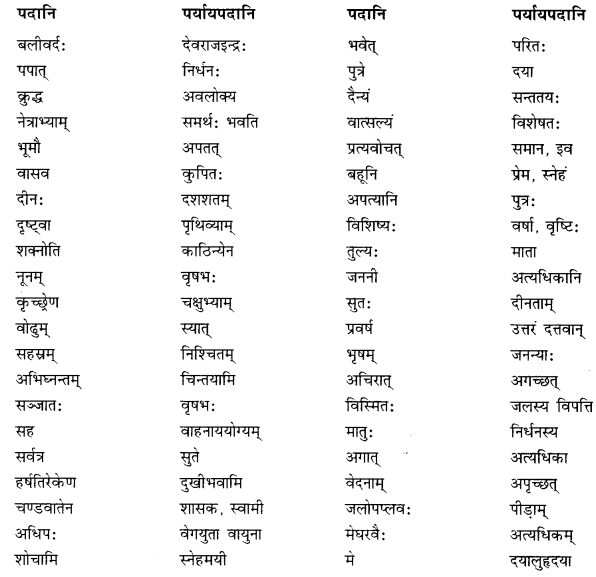

उत्तराणि:
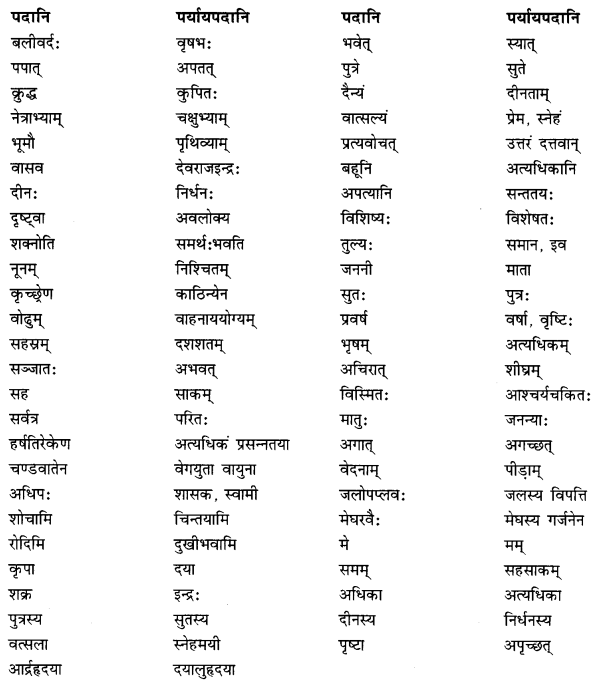
9. (अ) विशेषण-विशेष्यपदानि योजयत-
विशेषणपदानि – विशेष्यपदानि
(क) एकः – (i) वृषभ
(ख) दुर्बलं – (ii) पुत्रेषु
(ग) क्रुद्धः – (iii) पुत्रस्य
(घ) अधिकेषु – (iv) सुते
(ङ) दीनस्य – (v) कृषक:
(च) दुर्बले – (vi) कृषीवल:
उत्तराणि:
(क) (v), (ख) (i), (ग) (vi), (घ) (ii), (ङ) (iii), (च) (iv)
(आ) संस्कृतेन वाक्यप्रयोगं कुरुत-

उत्तराणि:
(क) उत्कृष्टानि मन्दिराणि दर्शनीयानि सन्ति।
(ख) वैदेशिकाः पर्यटकाः अपि अत्र अगच्छन्ति।
(ग) मोहनः योग्यः वरः अस्ति।
(घ) सा तु निर्भीका महिला अस्ति।
10. उचितानि विपर्ययानि मेलनं कुरुत-
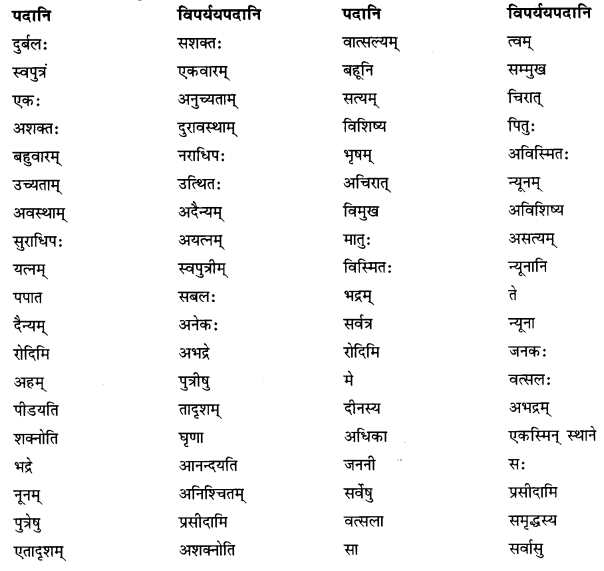
उत्तराणि:
